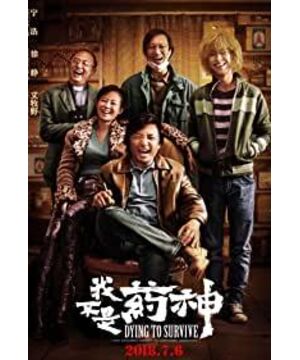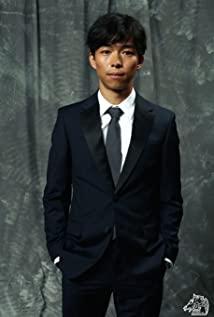In 2014, Lu Yong, a patient with chronic myeloid leukemia, was prosecuted by the Yuanjiang City Procuratorate of Hunan Province on suspicion of "selling counterfeit drugs" for helping thousands of patients buy the Indian imitation Swiss anticancer drug "Gleevec". 493 leukemia patients They jointly wrote a letter asking the judicial authorities to exempt Lu Yong from criminal punishment. In January 2015, the prosecution finally made a decision to withdraw the case, and Lu Yong was acquitted.
This incident became the story prototype of the movie "I am not the God of Medicine". The movie is a hit, but the questions behind the event still haunt people.
When the Lu Yong case first broke out in 2014, we had an exclusive interview with Lu Yong, asking him to tell about his experiences before and after his illness and the reasons for buying Indian generic drugs. After the case of Lu Yong, we hope that everyone can pay more attention to more medical dry goods, so we also present a related book integration.
Why should "generic drugs" be classified as "fake drugs"? Is Lu Yong's behavior considered "selling counterfeit drugs"? How to solve the current situation that many domestic patients cannot afford the high drug costs and turn to foreign "generic drugs"? Can the domestic drug management system and medical security system solve this situation?
In fact, this incident exposed a very profound social problem. A book can be written to explore how the general public in China can legally use the new anti-cancer drugs. It is very likely that the final solution must be the joint efforts of the government, pharmaceutical companies, public welfare, and patients, and neither party can undertake it alone.
Written | Beijing News reporter Zhang Ting
Only two or three kinds of targeted therapy drugs are independently developed in China
In 2002, Lu Yong from Wuxi, Jiangsu Province was diagnosed with chronic myeloid leukemia, and then started taking the anticancer drug "Gleevec" produced by Swiss company Novartis. This drug can stabilize the condition of patients with chronic myeloid leukemia and maintain a normal life, but continuous medication is required. The price per box (120 capsules) is 23,000-25,000 yuan.
Lu Yong introduced to the Beijing News reporter that in 2004, he accidentally learned that India was producing a generic drug of "Gleevec", but the price was only 3,000 yuan. After trying an Indian "generic drug" for a month, all the indicators were normal. In August 2004, Lu Yong informed chronic myeloid leukemia patients about the news of generic drugs in India. In August 2011, at the suggestion of several patients and Indian pharmaceutical companies, he purchased three credit cards with international remittance function. company.
On November 23, 2013, Lu Yong was arrested by the Yuanjiang City Public Security Bureau of Hunan Province for purchasing a credit card issued with someone else's ID card in a Taobao store, on the charge of obstructing the order of credit card management. After investigation, Lu Yong was found to have committed the crime of selling counterfeit drugs in addition to obstructing the order of credit card management.
In March 2014, Lu Yong was released on bail pending trial. On July 21, the Yuanjiang City Procuratorate in Hunan Province prosecuted Lu Yong for the crime of obstructing credit cards and selling counterfeit drugs.
The judiciary prosecuted Lu Yong for "selling counterfeit drugs" because the generic drug produced in India has not been approved by the domestic drug regulatory department and is a "counterfeit drug". What is a generic drug? What are the domestic laws and regulations?
The concept of "generic drugs" began in the United States in 1984. At that time, there were about 150 commonly used drugs in the United States that had expired patents, but big drugmakers thought they were unprofitable and were reluctant to continue developing them. These drugs became unclaimed drugs. The United States promulgated a law that new manufacturers only need to prove that their products are equivalent to the biological activity of the original drug to be imitated, thus the concept of "generic drugs" emerged. "Generic drugs" and "patented drugs" are exactly the same in dosage, safety, efficacy, quality, function, and indications, but the average price is only 20%-40% of the patented drugs, and individual varieties even differ by more than 10 times.
In China, due to the high price of domestic drugs, many patients who cannot afford drugs from regular channels choose to purchase generic drugs from countries such as India.
Professor Jiang Qian, director of the Department of Hematology, Peking University People's Hospital, introduced that at present, the treatment of chronic myeloid leukemia is mainly based on targeted therapy drugs. Bone marrow transplantation and chemotherapy have been seldom chosen because of their huge side effects and frequent relapses. In terms of targeted therapy drugs, "Gleevec" has become the most recognized targeted therapy drug by the academic community and patients because of its earliest invention and the most stable clinical effect.
"At present, there are more than 150 kinds of targeted therapy drugs in the world, and there are only 2 or 3 kinds of innovative targeted therapy drugs independently developed in my country, which are concentrated in the field of lung cancer and lymphoma." Director of Harbin Institute of Hematology and Oncology, chronic myeloid leukemia Expert Ma Jun introduced that in the field of chronic myeloid leukemia, my country has no innovative targeted therapy drugs independently developed.
The generic drugs purchased by domestic patients from India mainly include Gleevec for the treatment of leukemia, Herceptin for the treatment of breast cancer, Iressa for the treatment of lung cancer, and Nexavar for the treatment of renal cell carcinoma and liver cancer.
According to public reports in the media, these anti-cancer drugs are imported from European and American pharmaceutical companies, and they are expensive in China. Iressa costs more than 5,400 yuan per box, and 3 boxes per month are at least 16,200 yuan; Gleevec is at least 23,000 yuan per month for one box. Such high prices have forced many cancer patients to choose to purchase generic drugs from India.
The number of domestic generic drug users is gradually increasing
As a "big player" of generic drugs, India was once known as the "pharmacy of the world". Why can India produce "generic drugs"? After a pharmaceutical company or drug inventor invents a new drug, it needs to apply for a patent in different countries to obtain the special protection of the patent. Taking "Gleevec" purchased by Lu Yong as an example, the Swiss pharmaceutical company Novartis applied for a patent for "Gleevec" in my country. During the patent protection period, Chinese pharmaceutical companies are not allowed to produce related "generic drugs". This is also the reason why my country has not been able to produce "Gleevec" generic drugs in the past ten years.
In the practice of drug management in various countries, for the purpose of protecting public interests, and also to prevent the patentee from arbitrarily abusing the patent monopoly privilege, there are many countries that have left a room for "patent privilege" that can be worked around, that is, "Patent Compulsory License" system. The "patent compulsory license" system means that under special circumstances (such as endangering public health, obstructing national interests, etc.), the government can grant or license other companies to use a patent without the consent of the patentee.
A staff member of the Department of Treaty and Law of the State Intellectual Property Office told the Beijing News that although my country has a "compulsory license" related system, no individual or government department has applied for a compulsory license. Therefore, the compulsory license system has never been used in the fight against cancer. implemented in the field of medicine.
However, India's patent protection laws are relatively loose, and the enforcement of pharmaceutical patent protection in India is not as strict as in my country. The Indian Patent Law, which came into effect in January 2005, only provides patent protection for new drugs invented after 1995 or for drugs that have been improved to greatly improve their efficacy, and does not support patents on mixtures of original drugs or derived drugs. At the same time, the Indian government has also implemented a "compulsory license" system as needed. Therefore, India can ignore the restrictions of patent protection laws and produce a large number of generic anti-cancer drugs.
However, India's approach has also caused a lot of controversy internationally. To this day, there are still many generic drugs in India that are being sold while fighting patent legal battles with the original R&D manufacturers.
In response to this case, some media called for China to learn from some developed countries "paying the bill through medical insurance" to resolve the contradiction between "protecting intellectual property rights and the life-saving needs of a large number of patients", but Ma Jun told a reporter from the Beijing News that in April 2013, " The term of patent protection for "Gleevec" in my country has expired. In July 2013, my country has begun to produce "Gleevec" generic drugs, the price of which is about 3,000 yuan per box. And since 2013, more and more provinces, municipalities and autonomous regions across the country have included "Gleevec" into the scope of medical insurance, regardless of whether imported "Gleevec" or domestic imitation "Gleevec" is within the scope of reimbursement. .
Liu Kaiyan, deputy director of the Institute of Hematology at Peking University, also said that from a clinical point of view, the number of patients using domestic Gleevec generic drugs is gradually increasing. (Better) is the psychological effect."
"At present, my country already has its own 'Gleevec' generic drugs. But the current price of 3,000 yuan per box is indeed expensive compared to Indian generic drugs." Jiang Qian called for the domestic generic "Gleevec" drugs. The price of Gleevec still needs to be reduced, and at the same time, more regions need to include the "Gleevec" drug in the scope of medical insurance.
Ma Jun said that at present, a variety of preferred imported drugs for the treatment of lung cancer, breast cancer and other major diseases in my country have been included in the scope of medical insurance. Ma Jun estimates that imported drugs for major diseases included in the scope of medical insurance have accounted for about 20%, and more in the future. There is also a trend for imported drugs to be included in health insurance. Regarding the patent rights of imported drugs, Ma Jun said: "In recent years, the patent rights of many imported drugs have expired one after another, which means that in the next few years, we will have more drugs like 'Gleevec' that can be produced as generic drugs. ."
Knowing Lu Yong's case, let's talk about the medical "dry goods" of generic drugs and cancer as a whole.
Text | Pineapple
Are Generic Drugs Fake Drugs?
The continuous progress of human medical care is inseparable from the continuous emergence of new drugs. Whether it is antibiotics in Western medicine, Viagra, or Yunnan Baiyao and Niuhuang Qingxin Pill in traditional Chinese medicine, they all make periodic contributions to treating diseases and improving the quality of life of patients.
In modern society, when a new drug is just launched, it is accompanied by patent protection and brand name. Therefore, new drugs are also called "patented drugs" or "branded drugs", and "generic drugs", as the name suggests, are drugs that imitate "patented drugs". . In layman's terms, it is what we often call "shanzhai".
Similar to other copycat products, the biggest advantage of generic drugs over patent drugs is price. The average price of generic drugs is only 10% to 15% of the price of patented drugs. For anticancer drugs that cost tens of thousands of dollars every month, the option of generic drugs is very attractive.
But will generic drugs have the same quality problems as other copycat products?
True generics do not. In most countries, the bar for a generic drug to be marketed is very high. The U.S. FDA stipulates that a generic drug must be "identical to the patented drug in terms of active ingredient, dosage, safety, potency, action (including side effects), and disease for which it is intended." This is called "consistency evaluation" in China.
For example, "Goubuli" is a patented bun of a brand. To make an imitation bun called "Zigbuli", then "Zhubuli" must be based on the size of the bun, the ingredients of the seasoning, the ratio of meat and vegetables, the number of pleats, and the finished product. The speed of post-digestion and excretion is consistent with "Goubuli".
In fact, the official Indian generic "Gleevec" is 100% the same as the Swiss Novartis brand "Gleevec". The effect of the generic drug itself has also been tested by countless chronic myeloid leukemia patients, and it is no different from the brand drug. .
Therefore, in terms of efficacy alone, it is definitely not a fake drug, but a real real medicine and good medicine. However, because India's imitation Gleevec has not been registered or approved for marketing in China, it is a black market product, which is why it has been given the title of "fake drug".
It is very interesting that after Gleevec's global patent expired in 2013, many Chinese pharmaceutical companies can legally produce generic Gleevec. It is reasonable to buy domestic generic drugs. Why do people still take the risk of buying Indian generic drugs? ?
Or the price to blame! Because the price of domestic generic drugs is still much higher than that of Indian generic drugs.
Patented drugs have to be so expensive
Last time someone scolded on the Internet, saying that the manufacturing cost of Apple mobile phone is only more than 1,000, and it actually sells for 5,000! If you are told that the production cost of anticancer drugs is only 100 yuan, but it is sold for 10,000 yuan, everyone may go crazy. Let me tell you again that Sovaldi, a miracle drug for hepatitis C that was launched in 2014, costs 900 yuan to produce and sells for 500,000 in the United States.
Is it because the pharmaceutical companies are too greedy and ignore the life and death of their patients?
it's not true.
Whether it is an iPhone or an anti-cancer drug, the main cost is not in the raw materials and production, but in the research and development before the listing and the marketing after the listing.
Now the research and development cost of a new drug is getting higher and higher, which has exceeded 1 billion US dollars. Even if it goes well, it will take about 10 years, and most of them will fail. Why do pharmaceutical companies do such a high-risk thing? It is because new drugs are patented after they come out that they can monopolize the market for many years. During these years, high prices are set for drugs, so that the cost of developing drugs can be recovered. Medicine is a special commodity, but a pharmaceutical company is a commercial company after all. In order to develop continuously, it must make a profit.
Generic drugs are cheap because they have almost no research and development costs, saving hundreds of millions of dollars and 10 years. So generic drugs, although cheap, can be very profitable. If the patent drug market is not given the opportunity to monopolize and let the pharmaceutical companies see the possible profiteering opportunities of new drugs, the pharmaceutical companies will not have any motivation to do scientific research and develop new drugs. The final result is that everyone sells generic drugs or uses money to invest in real estate, and there will be no innovation and progress in pharmaceuticals themselves.
Of course, due to the particularity of drugs, the government will not allow the market to be monopolized for a long time, and the patent protection for new drugs is limited in time, generally 20 years. But these 20 years are not counted from the time the drug is launched, but from the very early stage, before the drug enters clinical trials. Since the development of drugs takes more than 10 years, when many patented drugs are listed, more than half of the 20-year patent protection period has passed. The real monopoly of new drugs in the market is only a few years. After that, the patents expire and generic drugs will enter in large numbers, greatly driving down drug prices. From another point of view, this prompts pharmaceutical companies to set drug prices as high as possible during the short monopoly period. After all, the Spring Festival is short and the good days are limited.
In a word, for the continuous operation of the new drug R&D system of the whole society, patented drugs must be expensive, even more expensive, in order to maintain their attractiveness to innovative pharmaceutical companies. It is impossible to expect patented drugs to drop to the same price as generic drugs.
Taking a step back, even if the monthly sales of 10,000 anti-cancer drugs are reduced to 2,000, I am afraid that it still cannot solve the problem that many people cannot afford the drugs. So the fundamental question is not whether the patented drug is too expensive, but whether there is a better system to help low-income patients pay for it.
I can think of a few general directions:
Pharmaceutical companies: Change the mode of drug development, especially actively search for biomarkers that can predict efficacy, accurately search for clinical trial populations, reduce the scale of clinical trials, improve the success rate, and reduce costs.
Government: Promote local drug development and increase competition. Actively promote medical insurance negotiation and reduce the price of access drugs. Fight against ineffective "Chinese magic medicine" and prevent patients from wasting precious funds.
Individuals: Purchase critical illness insurance in advance to avoid fluke mentality. Look for reliable sources of information, and don't blindly follow the "enthusiastic people" around you and the "magic doctors" hidden in the mountains.
Public welfare: Help people in real need receive the most basic and effective medical care, but must improve the efficiency of fund use and avoid giving money to individuals.
Why India has cheap generic cancer drugs
while China does not
For a long time, anti-cancer drugs such as "Gleevec", "Iressa", and "Nexavar", except for expensive brand-name drugs, only India has cheap generic drugs, and no other parts of the world have them. why is that?
There are two reasons. First, the level of generic drugs in India is very high; second, the Indian government does not do anything about patent protection.
Under normal circumstances, generic drugs must be marketed after the patent of the brand-name drug expires, otherwise the patent will become a display? For example, the global patent of "Gleevec" expired in 2013. Before that, in theory, other manufacturers could not sell generic drugs, otherwise it would be an infringement. The United States, Europe, and even China strictly enforce drug patent protection. Many pharmaceutical factories in these places have long wanted to imitate "Gleevec". In fact, many companies have even made generic drugs, but they can only store them in warehouses and dare not sell them. They are eagerly waiting for the day when the patent expires in 2013. Zero o'clock struck.
But the Indian government does not follow this suit. It has moved out the most ruthless trick in patent law: compulsory licensing.
"Compulsory license" is a check and balance regulation added in the patent law to prevent companies from abusing patent rights. Simply put, the government can, under certain circumstances, force payment without the patent's expiration and without the consent of the patent owner. With a small patent transfer fee, generic drug companies are authorized to legally copy and sell the same drugs. To put it bluntly, the government can "force buy". It's like a triad boss who found the chairman of "Goubuli" and said that I will take your steamed bun recipe first, and then find someone to produce it later, but don't be sad, it is still good, because I will sell you a steamed bun. penny.
The original meaning of the "compulsory license" regulation is to prevent backward countries from being unable to ensure national basic medical care and national security because they cannot afford patented medicines. It is usually used when infectious diseases break out, such as AIDS and Ebola. In many countries, anti-AIDS drugs are "compulsory licenses", which are sold very cheaply and are guaranteed to be available to everyone. Among them are not only African countries, but also not particularly poor countries such as Thailand and Brazil.
The use of "compulsory licenses" for anticancer drugs is far more controversial, because cancer is not contagious, and the harm to the whole society is not as great as infectious diseases, and it will not pose a threat to national security. But on the other hand, the poor cannot afford anti-cancer drugs and can only wait to die. Is it also considered that the national basic medical care is not guaranteed, which is detrimental to national security? So the various stakeholders began to quarrel.
While other countries were still arguing about democracy, the Indian government took decisive action and, without further ado, "compulsorily licensed" several of the most important anti-cancer drugs from European and American pharmaceutical companies, and authorized them to be imitated by local Indian pharmaceutical companies, including those mentioned above. "Gleevec", "Iressa", "Nexavar". The reason given by the Indian government is that these medicines are too good, but the Indian people can't afford them, so I'm sorry. After the emergence of generic drugs, the prices of these drugs in India dropped by more than 90% in an instant. Due to the high level of generic drug companies in India, the quality of drugs is very good, and the real price is cheap and sufficient. These generic drugs not only meet the domestic demand in India, but also become a popular source of smuggled drugs.
India's approach has been warmly welcomed by the uninsured masses and charities, but the patented pharmaceutical companies are irritated but can do little. Novartis protected the "Gleevec" patent, and after more than ten years of litigation with the Indian government, it was finally judged by the "Indian government" and lost to the "Indian government". How is it possible to win a lawsuit with the government?
"Compulsory licensing" is a double-edged sword. It has helped many developing countries solve basic medical problems, but at the same time, pharmaceutical companies have no interest in developing drugs for developing countries, because they can't sell for much money when they are made. Such projects are often only driven by philanthropy, such as the Gates Foundation.
The Ebola virus has been rampant in Africa for a long time, and there has been no cure or vaccine. The main reason is that there is no money to make. In 2014, there was another outbreak in Africa, with countless deaths, but because it spread to Europe and the United States, it immediately attracted the attention of many pharmaceutical companies. In just one year, several companies' Ebola vaccines and drugs have cured monkey models and even achieved good clinical results. To promote new drugs, there must be economic interests.
I guess that in the future, India will conduct "compulsory licenses" for more new anti-cancer drugs during the patent protection period, while most countries in the world, including China, should not. The debate over whether to give priority to patent protection to encourage innovation or to protect patients will continue for a long time.
This is bound to be a topic without a correct answer.
This article is exclusive content. Author: Zhang Ting, reporter from the Beijing News; Pineapple; Editor: Walk around, from one to one. The content of the interview was originally published in the "Beijing News" on December 24, 2014, on the b17 "Chinese Eyes" page. The content of the book was selected from "Cancer Truth: Doctors Are Reading", published with the authorization of the publisher, Tsinghua University Press. :Pineapple. The content of this article may not be reproduced without the written authorization of the Beijing News, and you are welcome to forward it to the circle of friends.
View more about Dying to Survive reviews











